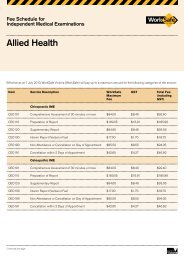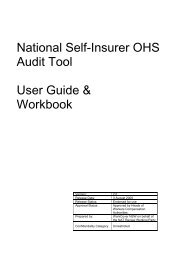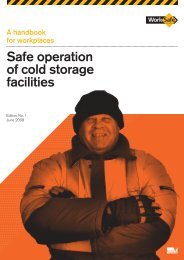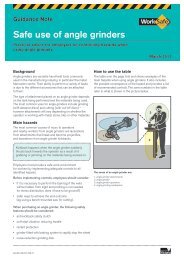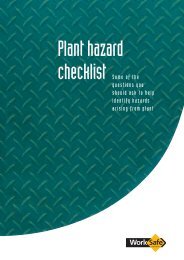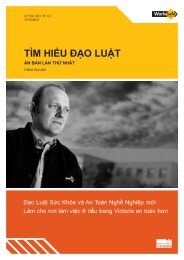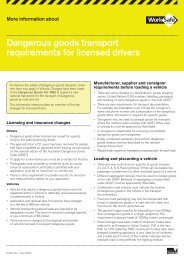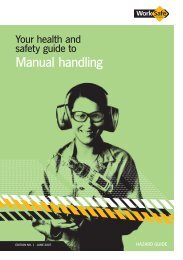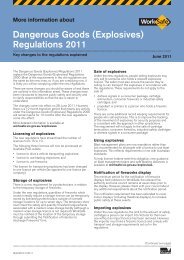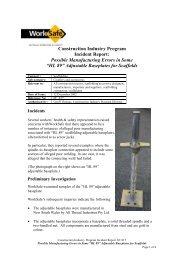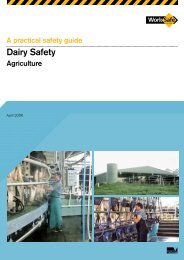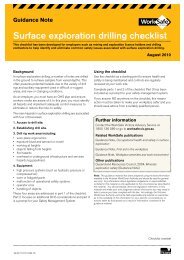Health and Safety in Shearing (PDF 917kb) - WorkSafe Victoria
Health and Safety in Shearing (PDF 917kb) - WorkSafe Victoria
Health and Safety in Shearing (PDF 917kb) - WorkSafe Victoria
You also want an ePaper? Increase the reach of your titles
YUMPU automatically turns print PDFs into web optimized ePapers that Google loves.
7.7 NoiseAs a guide, if it is difficult to have a normalconversation at about a distance of one meter <strong>in</strong> anoisy workplace then there may be a noise problem.To properly assess the risks it is necessary to measurethe noise <strong>and</strong> the exposure of workers to the noise <strong>in</strong>accordance with the <strong>Victoria</strong>n Noise Regulations 1992.This will identify the real noise problems <strong>and</strong> ensurethat any noise control undertaken will be worthwhile<strong>and</strong> effective. Maximum permissible exposure is asound level of 85 dBA for eight hours per day orequivalent.Hazard or riskRisk controlExposure to high noise levels over time causes When choos<strong>in</strong>g new equipment or mach<strong>in</strong>ery considerpermanent <strong>and</strong> untreatable hear<strong>in</strong>g loss. High noise the noise it produces <strong>and</strong> f<strong>in</strong>d out if less noisylevels sufficient to damage hear<strong>in</strong>g may be produced equipment is available. Sometimes mufflers or similarby shear<strong>in</strong>g mach<strong>in</strong>ery (particularly the long <strong>and</strong> add-ons such as noise covers that reduce noiseshort guts <strong>in</strong> the ferrule as well as the drive cogs), are available.wool presses, gr<strong>in</strong>ders, eng<strong>in</strong>es, motors, hydraulic Sometimes noisy equipment can be located awaypumps <strong>and</strong> radio/cassette/CD players.from the ma<strong>in</strong> work areas to m<strong>in</strong>imize the numberof workers who will be exposed to it.Proper ma<strong>in</strong>tenance <strong>and</strong> repair of mach<strong>in</strong>ery <strong>and</strong>equipment, particularly overhead gear, will usuallyreduce noise levels.Limit the use <strong>and</strong> volume of radio, CD <strong>and</strong> cassetteplayers if they produce too much noise. (Us<strong>in</strong>g thesedevices with earphones or earpieces is notrecommended <strong>in</strong> noisy environments because theyisolate the worker <strong>and</strong> prevent him/her from hear<strong>in</strong>gwarn<strong>in</strong>g signals <strong>and</strong> prevent communication withother people <strong>in</strong> the shed.)Use of proper earmuffs <strong>and</strong> earplugs will reduce noiseexposure but it may be difficult to use them becauseof hygiene <strong>and</strong> discomfort problems. They can also<strong>in</strong>terfere with the work or cause communicationproblems with workers who already have a hear<strong>in</strong>gproblem. If muffs or plugs are used, warn<strong>in</strong>g signsmust be erected, tra<strong>in</strong><strong>in</strong>g <strong>in</strong> their use must beprovided <strong>and</strong> regular hear<strong>in</strong>g tests must be arrangedby the employer for exposed workersundertaken.It is better to try <strong>and</strong> reduce noise levels firstbefore us<strong>in</strong>g earmuffs or earplugs as a risk control.Corrugated iron walls found <strong>in</strong> many shear<strong>in</strong>g shedsreflect noise <strong>and</strong> <strong>in</strong>crease overall noise levels <strong>in</strong>the shed.Keep noise levels <strong>in</strong> m<strong>in</strong>d when choos<strong>in</strong>g build<strong>in</strong>gmaterials for new sheds. Consider <strong>in</strong>stall<strong>in</strong>g propersound <strong>in</strong>sulation <strong>in</strong> exist<strong>in</strong>g sheds.<strong>Health</strong> & <strong>Safety</strong> <strong>in</strong> Shear<strong>in</strong>g 29




